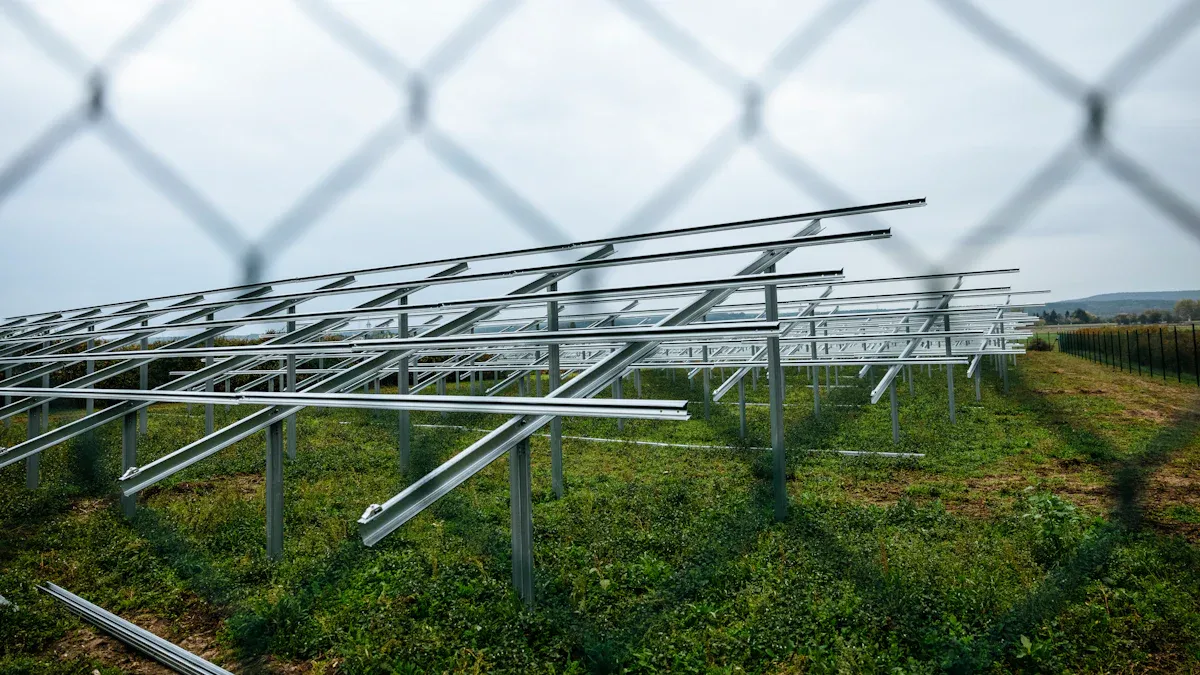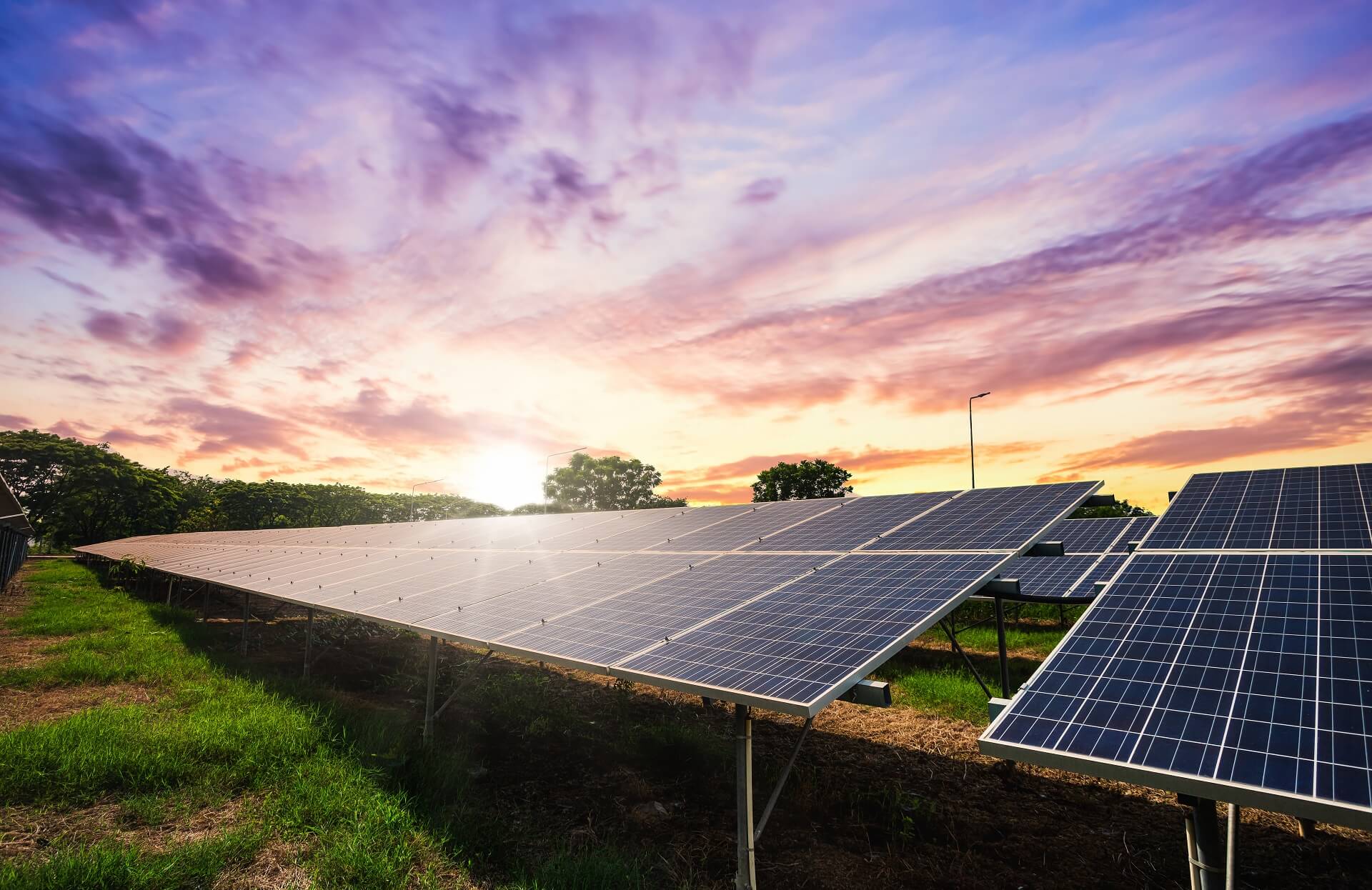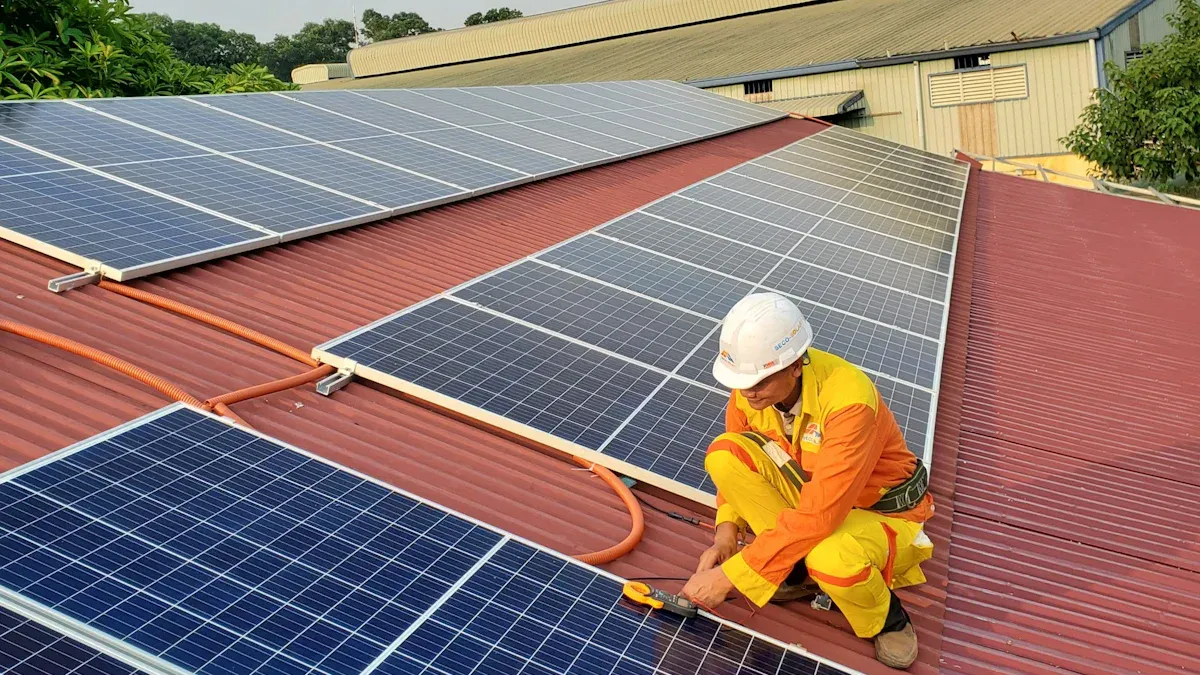ESTEL PV Mounting Steel: Always Reliable, Never Rusty

When you choose materials for PV mounting systems, durability and rust resistance matter the most. Galvanized steel offers exceptional protection against corrosion, making it ideal for long-term use. Its zinc coating shields the steel from moisture and oxidation, even in demanding outdoor applications. Hot-dipped galvanizing enhances this protection, ensuring the pv mounting steel structure withstands harsh conditions. Galvanised steel delivers reliability and strength, making it the preferred choice for robust installations. With its proven performance, you can trust galvanized steel to safeguard your investment and ensure lasting results.
Key Takeaways
Galvanized steel resists rust well, perfect for tough environments.
Its zinc layer shields the steel, making it strong and lasting.
Hot-dip galvanizing adds extra protection from water and damage.
Using galvanized steel helps solar panels last 50-75 years.
ESTEL's steel follows strict rules, working well in all climates.
The Importance of Corrosion Resistance in PV Mounting Systems

How galvanized steel prevents rust
Corrosion can significantly weaken PV mounting systems, reducing their lifespan and reliability. Galvanized steel provides a robust solution to this problem. Its outer zinc layer acts as a protective barrier, shielding the steel substrate from moisture and oxygen. This layer also serves as a galvanic anode, meaning it sacrifices itself to protect the underlying steel. As the zinc coating gradually wears away, the steel remains intact, ensuring long-term durability.
Hot-dip galvanizing enhances this protection by applying a thick zinc coating, typically 80 microns or more, as specified by standards like EN ISO 14713 and ISO 1461. This process ensures uniform coverage, even on complex structures, making galvanized steel ideal for PV mounting systems exposed to harsh conditions. Whether in arid deserts or coastal regions, the corrosion resistance of galvanized steel ensures structural integrity and reliable performance.
Studies have shown that the lifespan of galvanized steel structures depends on the durability of the zinc coating and the steel substrate. This combination provides decades of protection, making it a cost-effective choice for solar installations. By choosing galvanized steel, you can safeguard your PV mounting systems against rust and extend their service life.
Benefits of zinc coating in harsh environments
PV mounting systems often face extreme environmental challenges, from salty coastal air to high humidity in tropical regions. Zinc coatings on galvanized steel excel in these conditions, offering unmatched corrosion resistance. Scientific studies have demonstrated the effectiveness of zinc coatings in protecting steel from degradation. For example, heat-treated zinc coatings increase hardness without compromising corrosion resistance, ensuring durability in demanding environments.
Study Focus | Findings |
|---|---|
Heat Treatment of Zinc Coating | Increased coating hardness from 52 to 204 HV without reducing corrosion resistance. |
Corrosion Resistance | Zinc coatings effectively protect steel from corrosion in harsh environments. |
The zinc layer not only prevents rust but also maintains the structural integrity of PV mounting systems over time. This is particularly important for floating photovoltaic systems, where exposure to water and humidity can accelerate corrosion. Research highlights the need for corrosion-resistant materials in such applications, emphasizing the role of galvanized steel in ensuring reliability.
By choosing galvanized steel with zinc coatings, you equip your PV mounting systems to withstand the toughest environmental stressors. This choice minimizes maintenance costs and maximizes performance, making it the preferred solution for solar installations worldwide.
Durability of Galvanized Steel for PV Mounting Structures

Structural integrity under environmental stressors
Environmental stressors can challenge the structural integrity of PV mounting systems, but galvanized steel rises to the occasion. Its zinc coating acts as a shield, preventing corrosion-related failures and maintaining strength even in demanding conditions. Hot-dip galvanization further enhances this protection, ensuring the steel can withstand exposure to moisture, salinity, and other corrosive elements.
Performance data highlights how galvanized steel adapts to varying environments:
Condition | Performance Comparison | Notes |
|---|---|---|
Dry Air | Slightly inferior performance (-6% fatigue strength) | Complies with European normative requirements for double covered joints. |
Corrosive Environments | Significant strength increase (+12% to +52%) | Hot dip galvanization proves highly effective in preventing corrosion-related failures. |
These metrics demonstrate the versatility of galvanized steel. Whether you install PV systems in arid regions or coastal areas, the material ensures greater durability and reliability. Its ability to maintain structural integrity under stressors makes it a trusted choice for solar installations worldwide.
Tip: For installations in highly corrosive environments, consider periodic inspections to ensure the zinc coating remains intact. This proactive approach helps maximize the lifespan and durability of your PV mounting systems.
Longevity in diverse climates
Galvanized steel offers exceptional longevity across diverse climates, making it ideal for PV mounting structures. Its corrosion protection can last 50 to 75 years in many environments, ensuring your investment stands the test of time. Historical performance data collected from industrial, marine, and suburban areas between 1940 and 1980 confirms its resilience under varying conditions.
Advanced tools like the Zinc Coating Life Predictor calculate corrosion rates and predict service life, providing valuable insights for long-term planning. A 2001 study by ILZRO further validated the material’s improved longevity due to reduced sulfur and chloride emissions.
Metric | Value/Description |
|---|---|
Corrosion Protection Duration | 50 to 75 years in many environments |
Historical Performance Data | Collected from 1940 to 1980 across industrial, marine, and suburban environments |
Environmental Factors | Temperature, airborne salinity, sulfur dioxide concentration, relative humidity, rainfall, and sheltering conditions |
Software Used | Zinc Coating Life Predictor calculates corrosion rates and predicts service life |
Study Confirmation | 2001 study by ILZRO confirmed improved longevity due to reduced sulfur and chloride emissions |
Geographic Representation | Performance calculated for several North American cities with different corrosive climates |
Galvanized steel’s ability to endure diverse climates ensures consistent performance, whether your PV mounting systems face tropical humidity or freezing winters. By choosing galvanized steel, you secure a material that delivers both strength and longevity, reducing the need for frequent replacements or repairs.
Note: Coastal solar farms may require re-coating every 5 to 7 years to maintain optimal performance, as indicated by a 2022 report from the Solar Energy Industries Association (SEIA).
Cost-Effectiveness of Galvanized Steel Solutions
Reduced maintenance costs over time
When you choose galvanized steel for your PV mounting systems, you significantly reduce maintenance expenses over the years. The zinc coating on galvanized steel provides long-lasting protection, minimizing the need for frequent repairs or replacements. This durability translates into substantial cost savings, especially for large-scale installations.
A cost comparison highlights the financial benefits of galvanized steel. Hot-dip galvanizing costs only $0.03 per year, amounting to $0.90 over a 30-year project lifespan. In contrast, a two-coat paint system costs $0.15 annually, totaling $4.50 over the same period.
Maintenance Method | Cost per Year | Project Life (30 years) |
|---|---|---|
Hot-dip Galvanizing | $0.03 | $0.90 |
Two-coat Paint System | $0.15 | $4.50 |
This data demonstrates how galvanized steel offers a cost-effective solution for long-term PV mounting system maintenance. By choosing this material, you can allocate resources to other critical aspects of your solar projects instead of ongoing repairs.
Comparison with alternative materials
Galvanized steel stands out as a durable and budget-friendly option for PV mounting systems. Its zinc coating ensures resistance to corrosion, making it suitable for various environments. Alternative materials may vary in performance and cost, but they often lack the same level of durability.
Material | Advantages | Limitations |
|---|---|---|
Galvanized Steel | Durable and budget-friendly | May corrode in highly corrosive areas |
Alternative Material | Varies (not specified) | Varies (not specified) |
The National Renewable Energy Laboratory (NREL) reported that galvanized steel mounting systems in desert regions had an average lifespan of 10 years. In non-corrosive areas, this lifespan extended to 15 years. This durability ensures reliable performance in diverse conditions, making galvanized steel a preferred choice for PV installations.
By selecting galvanized steel, you benefit from a material that balances cost, durability, and performance. It reduces the need for frequent replacements, ensuring your investment delivers long-term value.
Environmental Sustainability of Galvanized Steel
Recyclability and eco-friendly properties
Galvanized steel stands out as a sustainable material due to its exceptional recyclability and eco-friendly properties. When you choose galvanized steel for PV mounting systems, you contribute to reducing waste and conserving natural resources. Steel is one of the most recycled materials globally, with a recycling rate exceeding 80%. This high rate ensures that old steel products can be repurposed into new ones without losing quality or strength.
The zinc coating on galvanized steel also supports sustainability. Zinc is fully recyclable, and its recovery process requires minimal energy. This makes galvanized steel an excellent choice for projects aiming to minimize their environmental footprint. By using materials that can be recycled repeatedly, you help reduce the demand for virgin raw materials and lower greenhouse gas emissions.
A cost analysis further highlights the eco-friendly advantages of galvanized steel. The table below compares the initial and total costs of various coating systems, showcasing the cost-effectiveness of hot-dip galvanizing (HDG):
Coating System | Initial Cost ($/ft²) | Total Cost ($) |
|---|---|---|
Hot-Dip Galvanizing (HDG) | 2.16 | 108,000 |
Epoxy / Epoxy | 3.20 | 159,800 |
Epoxy / Polyurethane | 3.45 | 172,350 |
Inorganic Zinc (IOZ) / Epoxy | 3.48 | 174,250 |
IOZ / Epoxy / Polyurethane | 4.98 | 249,050 |
HDG / Epoxy / Polyurethane (Duplex) | 6.65 | 332,600 |
Metallizing | 8.33 | 416,350 |
This data underscores how galvanized steel combines cost-effectiveness with sustainability, making it a smart choice for eco-conscious projects.
Sustainable practices in ESTEL’s manufacturing
ESTEL takes sustainability seriously by integrating eco-friendly practices into its manufacturing processes. The company prioritizes resource conservation, ensuring materials are used efficiently to minimize waste. By adopting waste-prevention initiatives, ESTEL reintegrates resources into production cycles, reducing the environmental impact of its operations.
You’ll appreciate how ESTEL promotes collaboration across the value chain to enhance sustainability. The company encourages stakeholders to adopt environmentally friendly technologies and tracks progress toward sustainable goals. This approach ensures continuous improvement in manufacturing methods.
Preserving the value of resources through conservation.
Preventing waste by reinstating materials into production flows.
Increasing awareness of circular economy principles.
Boosting educational initiatives that promote sustainable production.
ESTEL also invests in advanced technologies to reduce emissions and energy consumption. By focusing on these sustainable practices, the company aligns its operations with global efforts to combat climate change. When you choose ESTEL’s galvanized steel, you support a manufacturer committed to sustainability and recycling.
Why ESTEL’s Galvanized Steel is the Ideal Choice
Industry standards and certifications
When you choose ESTEL’s galvanized steel, you gain the assurance of materials that meet rigorous industry standards. These certifications validate the quality and reliability of the steel, ensuring it performs exceptionally in diverse conditions.
For instance, ESTEL’s galvanized steel complies with IEC 60529, which defines ingress protection standards. This ensures the steel resists dust and water penetration, making it suitable for outdoor installations. Additionally, it adheres to ISO 9227, a standard that evaluates corrosion resistance through salt spray testing. This certification guarantees the steel’s ability to withstand harsh environments, including coastal and industrial areas.
Standard | Description |
|---|---|
IEC 60529 | Ingress protection standards |
ISO 9227 | Corrosion resistance standards |
These certifications highlight ESTEL’s commitment to delivering high-quality materials. By choosing ESTEL, you ensure your installations meet global benchmarks for safety and durability.
Proven reliability in real-world applications
ESTEL’s galvanized steel has demonstrated consistent performance in real-world scenarios. Whether used in large-scale solar farms or rooftop installations, it delivers optimized performance under various environmental conditions. Its durability ensures structural integrity, even in challenging climates like high humidity or extreme heat.
For example, ESTEL’s steel has shown exceptional performance in Indian climates, where high temperatures and monsoons test material resilience. The zinc coating protects against corrosion, ensuring long-lasting installations with minimal maintenance. This reliability reduces downtime and enhances the efficiency of your solar projects.
You can trust ESTEL’s galvanized steel to provide unmatched durability and performance. Its proven track record in diverse applications makes it the ideal choice for your next installation.
Galvanized steel provides unmatched benefits for PV mounting systems. Its corrosion resistance, durability, and cost-effectiveness make it a smart choice for long-term use. You also contribute to sustainability by choosing this recyclable material.
Why choose ESTEL?
ESTEL’s PV mounting steel structure delivers proven reliability and meets global standards. It ensures your solar installations perform efficiently in any environment.
Make the right decision for your next project. Choose ESTEL to guarantee quality, durability, and performance that lasts. 🌟
FAQ
What makes galvanized steel ideal for solar panels?
Galvanized steel resists corrosion and maintains structural integrity in harsh environments. Its zinc coating protects against rust, ensuring long-term durability for solar panels. This makes it a reliable choice for installations in diverse climates.
How does ESTEL ensure the quality of its steel?
ESTEL adheres to global standards like ISO 9227 and IEC 60529. These certifications guarantee corrosion resistance and durability. You can trust ESTEL’s steel to perform well in real-world applications.
Can galvanized steel be used for photovoltaic solar panels in coastal areas?
Yes, galvanized steel works well in coastal regions. Its zinc coating prevents rust caused by salty air and humidity. Regular inspections help maintain optimal performance for photovoltaic solar panels in these environments.
Is galvanized steel environmentally friendly?
Galvanized steel is highly sustainable. Both steel and zinc are recyclable, reducing waste and conserving resources. Choosing this material supports eco-friendly practices in solar panel installations.
How long does galvanized steel last in solar panel systems?
Galvanized steel can last 50 to 75 years in many environments. Its durability minimizes maintenance and replacement costs, making it a cost-effective solution for solar panel systems.
See Also
Reliable Outdoor Enclosures: The Perfect Choice Every Time
Essential Advice for Outdoor Maintenance of ESTEL Cabinets
Simplifying the Installation Process for ESTEL Outdoor Cabinets
Requirements for Ensuring Longevity of Outdoor Telecom Cabinets
Comparing Durability Among Various Outdoor Communication Cabinets
CALL US DIRECTLY
86-13752765943
3A-8, SHUIWAN 1979 SQUARE (PHASE II), NO.111, TAIZI ROAD,SHUIWAN COMMUNITY, ZHAOSHANG STREET, NANSHAN DISTRICT, SHENZHEN, GUANGDONG, CHINA

